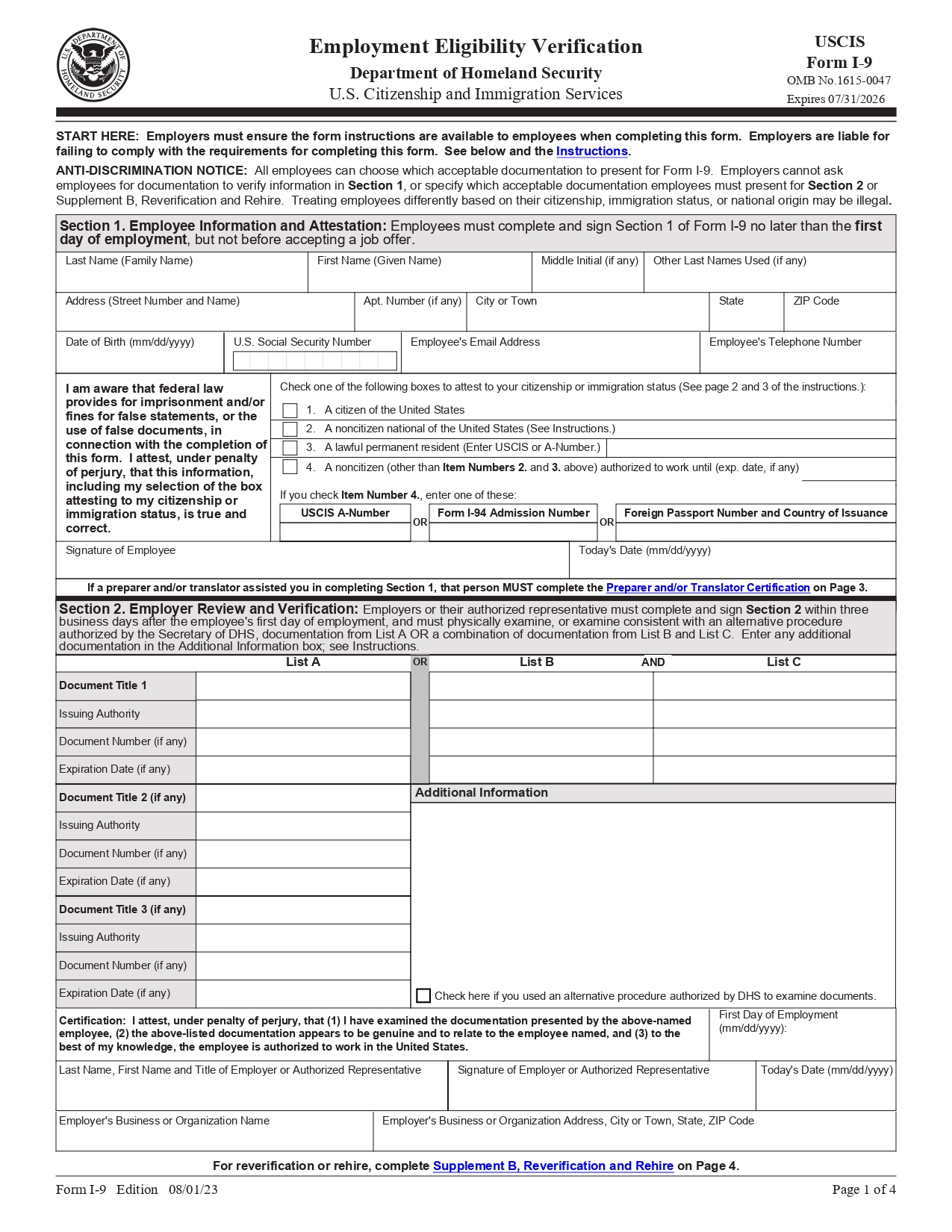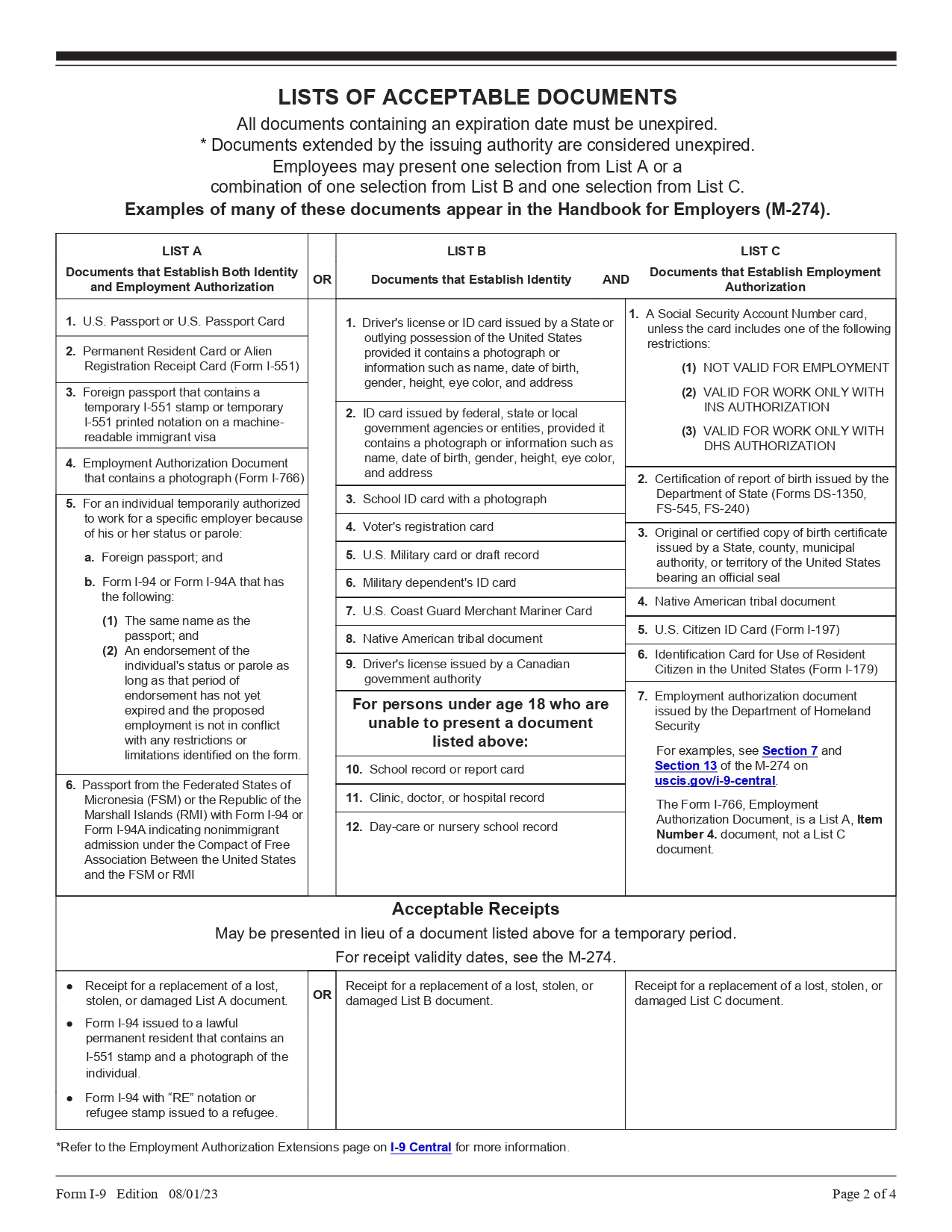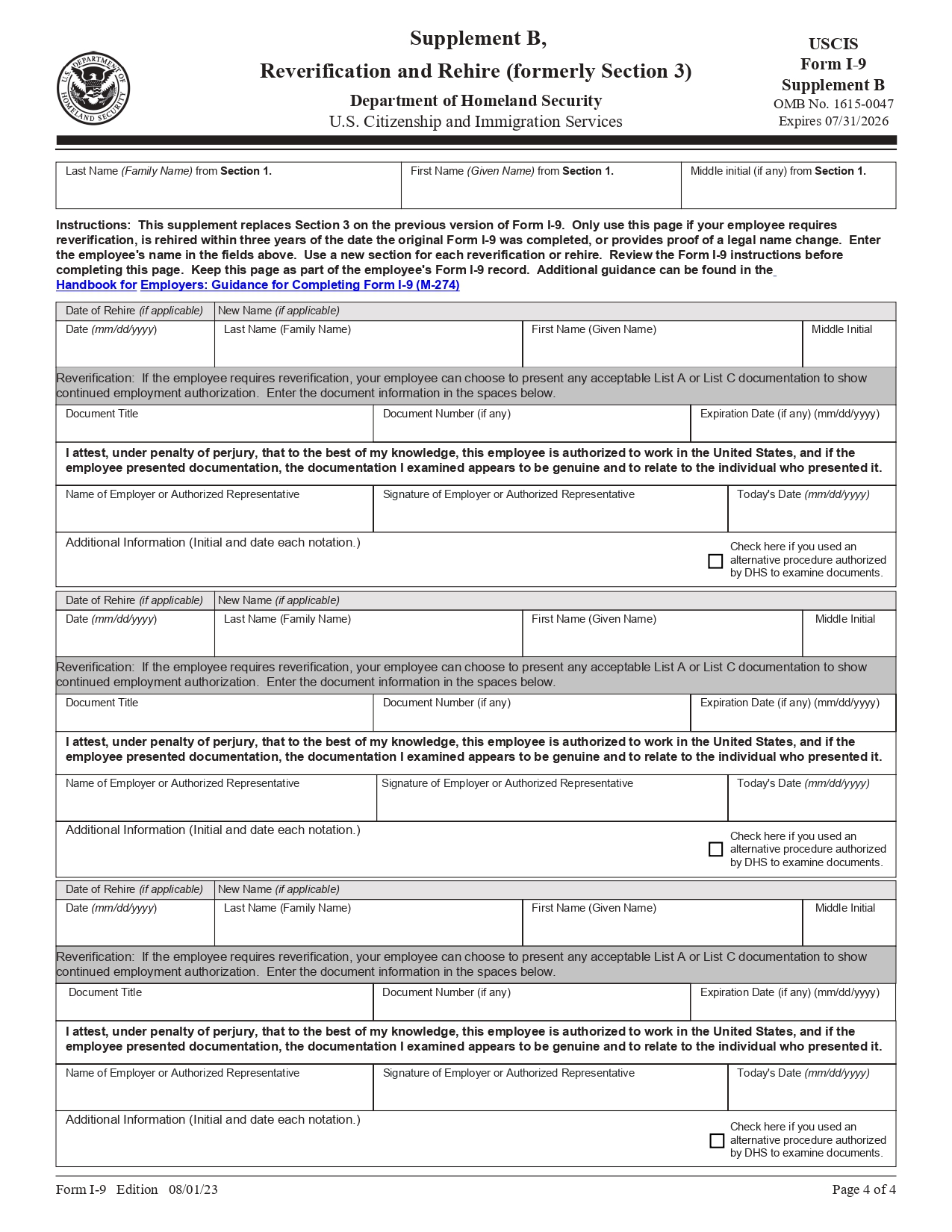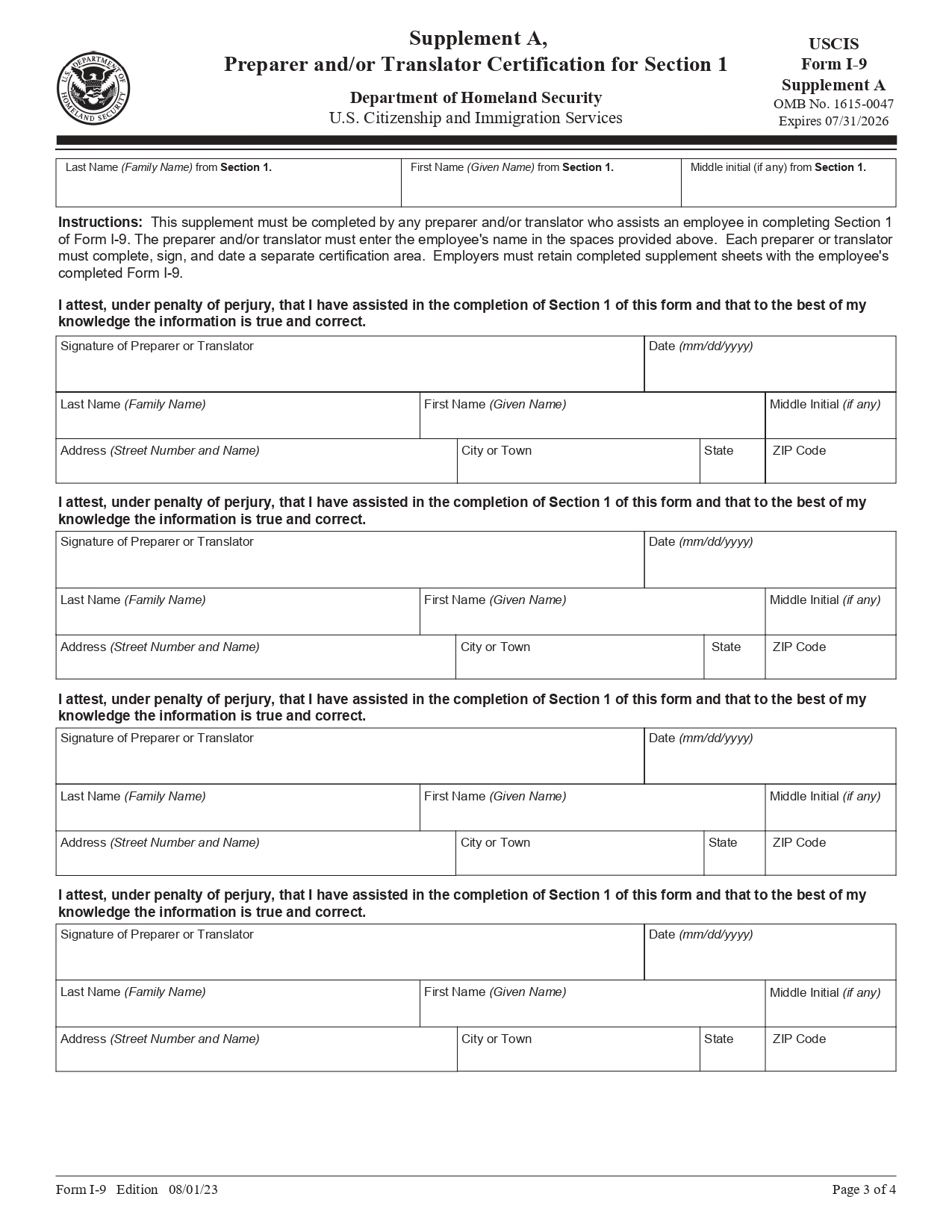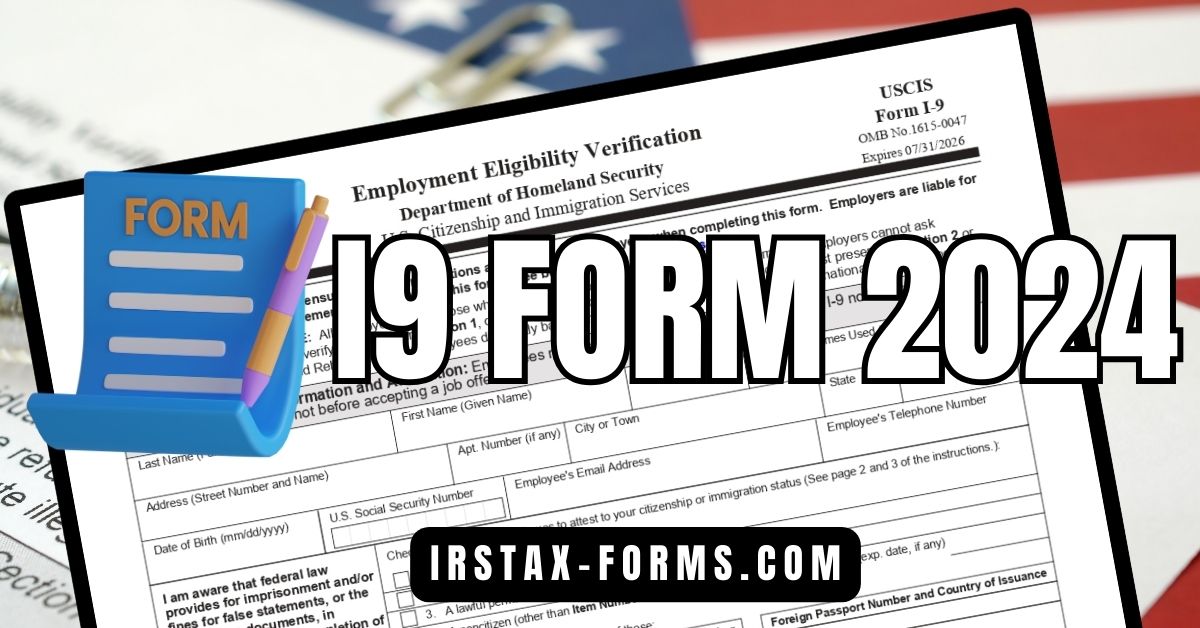Table of Contents
i9 Form 2024, Employment Eligibility Verification – Keeping up with the latest employment forms can be a real headache for business owners. The i9 Form 2024 is no exception, with its new updates and rules. It’s easy to feel overwhelmed, especially when you’re trying to run a business and stay on top of these legal requirements. Missing a detail on the I9 form isn’t just a minor oversight; it can lead to serious legal issues and fines that no business owner wants to face.
New Article: I9 Form 2025.
But there’s good news. Understanding the i9 Form 2024 doesn’t have to be a struggle. With the right information and a clear breakdown of what’s new and what’s changed, you can handle this like a pro. This article is designed to guide you through the new i9 Form, making it straightforward and manageable. We’ll cover everything you need to know, ensuring you’re up-to-date and fully compliant without the stress.
The Form I-9, issued by the U.S. Citizenship and Immigration Services (USCIS), is a document used for verifying the identity and employment authorization of individuals hired for employment in the United States.
What is the I9 Form?
The I9 Form, officially known as the Employment Eligibility Verification Form, is a mandatory document for all U.S. employers. Its primary purpose is to verify the identity and legal authorization of individuals hired for employment in the United States. This form is a critical component of the hiring process, ensuring that only individuals legally permitted to work are employed.
Every new employee, regardless of citizenship or national origin, must complete the I9 Form. The process involves filling out the form and providing acceptable documents that prove identity and employment authorization. Employers are responsible for examining these documents to determine if they reasonably appear to be genuine and relate to the employee presenting them. This process helps maintain a legal workforce and prevents the unlawful employment of unauthorized individuals.
Updating the I9 Form 2024
How Often Does i9 Need to be Updated?
The I9 Form needs to be updated primarily when an employee’s employment authorization document (EAD) or receipt expires. This is crucial for maintaining compliance with employment eligibility requirements. Employers must be vigilant in tracking these expiration dates to ensure timely updates.
In some cases, if an employee is rehired within three years of the date their previous I9 was completed, employers have the option to either complete a new I9 Form or update the existing one. Employers need to have a system in place to monitor these situations and act accordingly.
Changing Start Date on I-9 Form
If there’s a change in an employee’s start date after the I9 Form has been completed, employers can update the form. The correct start date should be crossed out, and the new start date should be written in. This change should be initialed and dated by the employer.
This process ensures that the I9 Form accurately reflects the employee’s actual start date, which is essential for compliance purposes. It’s a simple yet important step in maintaining accurate employment records.
How to Fill Out the New I9 Form 2024? A Detailed Guide!
Filling out the I-9 Form correctly is crucial for employers to comply with U.S. employment eligibility verification requirements. Here’s a step-by-step guide on how to complete the new I-9 Form:
Section 1: Employee Information and Attestation
Employee Completes on First Day of Employment
- Full Legal Name: The employee must enter their full legal name. If they have two last names (family names) or a hyphenated last name, they should include both.
- Other Names Used: If applicable, include any other names used (e.g., maiden name).
- Address and Date of Birth: Provide the current address and date of birth.
- Social Security Number: Employees must enter their Social Security Number (SSN).
- Email and Telephone Number: These fields are optional but can be filled out if the employee chooses.
- Citizenship/Immigration Status: The employee must attest to their citizenship or immigration status by checking the appropriate box (U.S. citizen, noncitizen national, lawful permanent resident, or alien authorized to work).
- Alien Registration/USCIS Number: If the employee is not a U.S. citizen, they must provide their Alien Registration Number/USCIS Number or Form I-94 Admission Number.
- Employee Signature and Date: The employee must sign and date the form.
Section 2: Employer or Authorized Representative Review and Verification
Complete Within 3 Business Days of the Employee’s First Day
- Document Review: The employer or authorized representative must physically examine one document from List A or a combination of one document from List B and one from List C. These documents must be original and unexpired.
- Record Document Information: Enter the document title, issuing authority, number(s), and expiration date(s) in the appropriate fields.
- Employer Information and Certification: The employer or authorized representative must enter the date of the employee’s first day of employment, their name, and title, as well as the business’s name and address.
- Signature and Date: The employer or authorized representative must sign and date the form.
Section 3: Reverification and Rehires (if applicable)
For Employees Rehired or Whose Work Authorization Requires Reverification
- Document Review: If the employee’s employment authorization or documentation of employment authorization has expired, the employer must reverify by examining either a List A document or a List C document.
- Record New Document Information: Enter the new document’s title, number, and expiration date.
- Signature and Date: The employer or authorized representative must sign and date this section.
Additional Tips
- Storage and Retention: Employers must retain completed I-9 forms for three years after the date of hire or one year after the date employment ends, whichever is later.
- Privacy: Ensure the privacy of the information provided by the employee. Store I-9 forms securely and allow only authorized personnel to access them.
- No Photocopies: Employees must present original documents, except for certified copies of birth certificates. Photocopies are not acceptable for I-9 verification.
- Avoid Discrimination: Employers must not specify which documents they will accept from an employee. The choice of which documents to present is the employee’s.
By following these detailed steps, employers can ensure they are filling out the I-9 Form accurately and maintaining compliance with employment eligibility verification requirements.
List of Acceptable I-9 Documents
The I-9 Form requires specific documents to verify an employee’s identity and employment authorization. These documents are categorized into three lists: List A, List B, and List C. Employers must examine these documents to ensure they are genuine and relate to the employee presenting them.
List A: Documents that Establish Both Identity and Employment Authorization
Employees can present one document from List A. These documents confirm both the employee’s identity and their authorization to work in the United States. Common List A documents include:
- U.S. Passport or U.S. Passport Card: A valid U.S. passport or passport card establishes both identity and U.S. citizenship.
- Permanent Resident Card or Alien Registration Receipt Card (Form I-551): Issued to lawful permanent residents as proof of their authorization to live and work in the U.S.
- Foreign Passport with a Temporary I-551 Stamp or I-551 Printed Notation: A foreign passport with a temporary I-551 stamp or printed notation on a machine-readable immigrant visa.
- Employment Authorization Document (EAD) that Contains a Photograph (Form I-766): Issued by USCIS to individuals granted temporary employment authorization in the U.S.
- Foreign Passport with Form I-94 or Form I-94A: A foreign passport accompanied by Form I-94 or I-94A bearing the same name as the passport and an endorsement of the alien’s nonimmigrant status, if that status authorizes the alien to work for the employer.
- Passport from the Federated States of Micronesia (FSM) or the Republic of the Marshall Islands (RMI): Accompanied by Form I-94 or I-94A indicating nonimmigrant admission under the Compact of Free Association Between the United States and the FSM or RMI.
List B: Documents that Establish Identity
If an employee does not have a document from List A, they must provide one from List B to establish identity and one from List C to establish employment authorization. List B documents include:
- Driver’s License or ID Card: Issued by a U.S. state or outlying possession.
- ID Card Issued by Federal, State, or Local Government Agencies: Provided it contains a photograph and other identifying information.
- School ID Card with a Photograph: Generally used by students.
- Voter’s Registration Card: Shows the name and photograph of the voter.
- U.S. Military Card or Draft Record: Issued to military personnel.
- Military Dependent’s ID Card: For dependents of military personnel.
- U.S. Coast Guard Merchant Mariner Card: Issued to U.S. Merchant Mariners.
- Native American Tribal Document: Issued by a recognized tribal organization.
- Driver’s License Issued by a Canadian Government Authority: For Canadian citizens working in the U.S.
List C: Documents that Establish Employment Authorization
List C documents are required alongside a List B document and are used to establish employment authorization:
- Social Security Account Number Card: Must be unrestricted. Restricted cards are not acceptable.
- Certification of Birth Abroad Issued by the Department of State (Form FS-545 or Form DS-1350): Certifies an individual’s birth abroad to U.S. citizen parents.
- Original or Certified Copy of a Birth Certificate: Issued by a U.S. state, county, municipal authority, or territory bearing an official seal.
- Native American Tribal Document: As listed under List B, but in this case, used for employment authorization.
- U.S. Citizen ID Card (Form I-197): Issued by USCIS to U.S. citizens.
- Identification Card for Use of Resident Citizen in the United States (Form I-179): Issued by USCIS to lawful permanent residents.
- Employment Authorization Document Issued by the Department of Homeland Security: Various forms of EADs issued to individuals granted temporary work authorization in the U.S.
Important Notes
- Employees must present original documents, except for certified copies of birth certificates.
- Employers are responsible for examining the documents to ensure they are genuine and relate to the employee presenting them.
- Photocopies or expired documents are not acceptable for I-9 verification purposes.
- Employers must not specify which documents they will accept from an employee. The choice of which documents to present is the employee’s.
Understanding these lists and the types of documents they include is crucial for employers to ensure compliance with the I-9 verification process.
New I-9 Rules for 2024: A Comprehensive Guide for Employers!
The Internal Revenue Service (IRS) has introduced a revised version of Form I-9, Employment Eligibility Verification, set to take effect for all new hires from 2024. This article provides a detailed overview of the significant changes and what employers need to know to stay compliant.
The new Form I-9 incorporates several key changes that are crucial for employers to understand. These modifications are designed to streamline the employment verification process and adapt to evolving work environments.
1) New E-Verify Checkbox
A notable addition to the new Form I-9 is a checkbox for employers participating in E-Verify. This checkbox is to indicate if they have remotely examined identity and employment authorization documents under an authorized alternative procedure by the Department of Homeland Security (DHS). This procedure permits remote document examination through video conferencing or other secure methods, a significant shift from traditional in-person verification.
2) Automatically Extended Employment Authorization Documents (EADs)
In response to the COVID-19 pandemic, USCIS announced an 18-month automatic extension of certain EADs from March 1, 2023. The new Form I-9 includes instructions on how to reverify employees with these automatically extended EADs. Employers must complete this reverification before the employees commence work on November 4, 2024.
3) Minor Changes
Apart from these major updates, the new Form I-9 also introduces minor alterations in instructions and layout. However, the fundamental requirements for completing the form remain unchanged.
4) Actions Required for Employers
To comply with the new regulations, employers should:
- Adopt the New Form I-9: Begin using the new Form I-9 as soon as possible. This ensures compliance and readiness for the 2024 implementation.
- Update Policies and Procedures: Review and update internal Form I-9 policies and procedures to align with the new changes.
- Understand the E-Verify Checkbox: Employers enrolled in E-Verify should familiarize themselves with the new checkbox and decide if they will adopt the alternative remote document examination procedure.
- Identify Employees with Extended EADs: Employers should review their records to identify employees with automatically extended EADs and ensure their reverification is completed timely.
The new I-9 rules for 2024 bring significant changes to the employment eligibility verification process. Employers must proactively adapt to these changes to ensure compliance and smooth operation. For any queries or assistance, employers can reach out to professional services like Capital Payroll Partners.
FAQS about I9 Form 2024
1) How Soon Does an I-9 Need to be Completed?
The I9 Form must be completed promptly to comply with employment eligibility verification requirements. Employees are required to complete Section 1 of the form no later than their first day of employment.
Employers must complete Section 2 of the I9 Form within three business days of the employee’s start date. This involves reviewing the employee’s documents and recording their information on the form. Timely completion of the I9 is crucial to avoid non-compliance penalties.
2) When is the I9 Form Required?
The I9 Form is required for every individual hired for employment in the United States after November 6, 1986. This includes U.S. citizens and noncitizens. Employers must ensure that the form is completed to verify the identity and employment authorization of each employee.
The form must be completed by both the employer and the employee. Section 1 of the form should be completed by the employee on their first day of employment, and Section 2, which includes document verification, must be completed by the employer within three business days of the employee’s start date.
3) Can a Blank I-9 be Reproduced?
Many employers wonder if they can make copies of a blank I9 Form. The answer is yes, you can reproduce a blank I9 Form, but there’s a catch. You must ensure that both sides of the form are copied. This is important because the form contains essential instructions and legal information on the reverse side that employees need to be aware of.
When reproducing the I9 Form, remember that the instructions and Lists of Acceptable Documents must be readily available to all employees completing the form. This ensures that employees understand the requirements and provide the correct documentation. It’s not just about having the form; it’s about ensuring that the process is clear and compliant.
4) Do You Need a Photocopy of I9 Form?
When it comes to photocopying completed I9 Forms, employers often get confused. While it’s not required by law to keep photocopies of the documents employees submit with their I9 Forms, doing so can be a wise practice. If you choose to keep photocopies, you must do it for all employees to avoid discrimination claims.
However, remember that photocopies of the I9 Form or its documentation cannot replace the original form. Employers must still have a completed original I9 Form for each employee. Photocopies can serve as a backup for reference or in case of an audit, but they are not substitutes for the actual, completed form.
5) When does the I9 Form, Eligibility Verification Expired?
Understanding the expiration of the I9 Form is crucial for employers. The form itself has an expiration date printed on it, but this can be misleading. Even if the form’s printed expiration date has passed, it often remains valid until a new version is issued by the U.S. Citizenship and Immigration Services (USCIS).
Employers must retain a completed I9 Form for each employee for three years after the date of hire or one year after the date employment ends, whichever is later. This retention rule is vital for compliance and can be critical during audits. Always check the USCIS website for the most current version of the form and any updates on its validity.
i9 Form 2024 Printable, Employment Eligibility Verification
Download, Fill, and Print i9 Form 2024, Employment Eligibility Verification: CLICK HERE
The I9 Form for 2024 is the edition dated 08/01/23, and it is set to expire on 07/31/2026.
i9 Form 2024 Images
